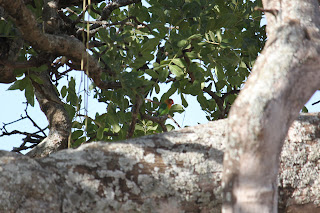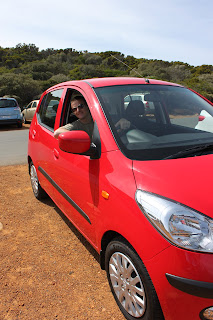There is a rotavirus outbreak going on in children in Muheza right now, so the pediatric wards are extremely full (up to 3 kids per bed- probably not the best for preventing further outbreak spread). They called in some epidemiologists from Dar to come and investigate the outbreak, so it has been very interesting to hear their process and the results of their investigation- especially having been on a diarrheal illness investigation in the US. They seem very competent, but sound discouraged by the state of the health record keeping here, which definitely leaves something to be desired. It is a hard job anywhere, and without good records it makes things even harder. Nevertheless, there does not seem to be one focus of the outbreak, and so they think it could be linked to a common source of drinking water. I have my doubts, but they are still investigating this hypothesis further.
I spent the majority of the week with Dr. Mbago on surgery, which was definitely an eye opener. On ward rounds, I saw people with huge hernias, a lady with a burn covering her skull, a woman with a visually and palpably obvious breast cancer, and a huge sarcoma enveloping a 20-something year old woman’s upper thigh and bursting out into a large black fungating mass. I will never forget the sight of that. Most patients are awaiting surgical repairs- hernia reductions, skin grafting, leg amputations. It was interesting to watch Dr. Mbago interact with the patients, and to see him break bad news to patients. For example, when we told the patient with the leg sarcoma that she would need amputation, there was very little reaction. The patients are much more stoic in Tanzania than they are back home. They are also much more accepting of the doctor’s judgment. Often during rounds the patients are not even really informed of what will be happening to them that day, and then before you know it they are being whisked off to the OR. There is a lot less discussion with patients and families than there would be in the States. I observed a thyroidectomy for a patient with a goiter- it was done under general anesthesia which means that the nurse anesthetist had to bag ventilate the patient with halothane the entire time. The anesthesia was also rather light in my opinion. I also was the first assist for a hydrocelectomy and subcapsular orchidectomy for a patient with prostate cancer. Instead of using medication to target androgens in these patients (androgens exacerbate the cancer’s growth), they surgically remove the insides of the testes to basically remove the hormone producing cells. I have never heard of or seen anything like it back home. Dr. Mbago is a very good teacher though, probably the best that I have encountered here. He spends a lot of time teaching me practical knowledge of what to do in emergencies in a resource-poor setting- from using a pen/latex glove to remove pressure and create a valve in someone with a tension pneumothorax, to how to relieve urinary retention, to classification and treatment of burns. It is very helpful, and is actually knowledge that I might have to use in the future.
Thursday was a national holiday, so there were not normal duties on the wards. We went with the British OB/GYN and her family to the Tanga Yacht Club (mostly for expat members), and hung out/went sailing on their old wooden dinghy and their Laser. There, I met a family from Riverside, CA who have been living here for the past 5 years doing physical therapy work. They used to live only a few blocks away from the Riverside Wondollecks! What a small world. I also met a family from Texas who have also been here for 5 years doing education and clean water projects. It was really interesting to speak with them about their experiences as Americans living abroad in Africa. It is rare that you meet Americans who are living in this area long term, it is much more often British and other European people. But it is definitely nice to see Americans also getting involved.
I spent Friday in the microbiology lab with Ben, the British OB/GYN’s husband. He taught me about their laboratory capabilities here and showed me a little of what they do every day (looking at malaria blood slides, growing bacterial plates for speciation, ongoing research project studies, etc). He is a wealth of knowledge on malaria and the other infectious diseases in the area. I asked about outbreaks, of which he says there haven’t been too many, but they have had cholera, rotavirus, and Rift Valley Fever outbreaks since he has been here. They have also isolated a new virus in the CSF of encephalitis patients that is derived from bats (scary because of the number of bats living in the trees around the hospital). It also turns out the Teule is a big research site and has contributed data to a number of high profile multi-center studies published in elite journals. It is nice to see that they are so involved in collecting data for science and hopefully for the advancement of medicine in the area. The lab itself is fairly well-equipped with freezers, microscopes, liquid nitrogen, blood culture machines, and everything else you might need. It still does suffer from some of the negatives of life in Africa- such as intermittent power (with backup generator) and (today) ants walking in bacterial culture plates and then spreading potential cholera bacteria all over the bench top.
I am in Dar es Salaam right now waiting to fly home! Last night in Dar, I met up with the English couple who I met at Peponi and were here doing palliative care. We went to dinner at a fabulous Ethiopian restaurant- to get me in the mood to fly Ethiopian Air home!
As I have reached the close of my elective time here, the following is a list of favorites/least favorites from my time here…
Things I will miss:
-The people here- both Tanzanian and wazungu
-Chapati
-Fish curry and naan from Food Palace
-Tanga Tuesdays
-Living on the campus of my workplace
-Tiny bananas
-Living at the foothills of the mountains but also by the sea
-Banana fritters
-Greeting everyone you pass on the street
-Speaking Swahili
-Really cute kids
-Pace of life here
-Chickens and monkeys walking around the hospital
-Chickens everywhere!
-How colorful life is here
-Waking up in Africa every morning
-Learning the intricacies of tropical medicine in a resource-poor environment
Things I won’t miss:
-Heat and humidity
-Peanut butter and bananas at every meal
-No running water
-Living with rats
-Language barrier
-Using DEET and sleeping under a mosquito net
-Having to go shopping at a million specialized shops (ie- water guy, banana guy etc)
-Having to be so careful about what I eat/drink
-Feeling dirty all the time
-Bats
-Feeling isolated from the rest of the world
-Jokes in a different language at my expense
-The smell of burning garbage
-Intermittent electricity
-Feeling helpless with limited resources in the face of advanced disease, and watching patients die because of these limited resources
Flying out in just a few hours... I still can’t believe how quickly the time has flown by. Thanks so much for following my experiences on the blog, and I can’t wait to see you all!




























 Afterwards, we had a fancy breakfast under a tent on the island that was boated over from one of the resorts along the river. The whole experience was awe-inspiring and definitely a highlight of our time here. Now our time here at the Falls has come to an end, and we are so glad we had the opportunity to experience it. Next up: South Africa!
Afterwards, we had a fancy breakfast under a tent on the island that was boated over from one of the resorts along the river. The whole experience was awe-inspiring and definitely a highlight of our time here. Now our time here at the Falls has come to an end, and we are so glad we had the opportunity to experience it. Next up: South Africa!











